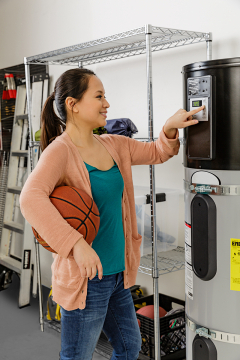Your home's most forgettable appliance could be wasting hundreds of dollars per year.

You probably don’t spend much time thinking about your water heater. And why would you? Maybe you cursed it that time you tried to do a load of laundry and draw a bath simultaneously, but by and large, water heaters lead quiet lives, tucked away in utility closets, basements, or garages.
But even though your water heater is out of sight, it’s still doing a number on your electric bill.
In fact, the water heater is the second-largest energy user in most homes, just behind heating and cooling, accounting for nearly 20 percent of the average home’s energy use. For comparison, that’s more energy than your refrigerator, dishwasher, and clothes washer and dryer combined.
So what’s an energy-savvy homeowner to do?
Turns out, it’s nothing heat pump technology can’t fix.

In case you’re not familiar with heat pump water heaters (HPWHs), basically they work like a refrigerator in reverse. Instead of pulling heat from surrounding air to keep food cold, a HPWH pulls heat into a tank to heat water. The result is an electric water heater that uses just one third the electricity of a standard electric model. They also have a longer warranty period: typically ten years, versus six years for a standard electric model.
According to EPA estimates, a family of four will save up to $330 every year by switching to an HPWH. Although HPWHs cost a little more up front than a traditional electric model, the ongoing savings means your HPWH will pay for itself within three years. And with a little help from rebates and special pricing offered by many electric utilities, chances are you can cut that payback time down to two years or less.
The easiest way to upgrade to an HPWH is to hire a professional installer. More DIY-inclined homeowners can install an HPWH without professional help, but there’s no shame in admitting you’d rather not lug a 175-pound appliance into one of the darkest corners of your home and hook it up.
If you are up for the challenge of a DIY install, there are a few things to keep in mind when it comes to HPWH installation.
HPWHs need room to breathe – Most manufacturers recommend 700 square feet or so. You’ll also need 220v power, which isn’t a problem if you’re just replacing an existing electric water heater. If you’re installing in a new location, you’ll want to get some help from an electrician.
Consider your home climate – HPWHs pull heat from air in the room, which lowers the temperature a bit. Installing your HPWH in a room with other heat sources (like a clothes dryer or furnace) is a great way to offset this effect so you aren’t paying to heat air for your HPWH to cool again.
HPWHs sound a bit like a refrigerator when they run – An HPWH is just like any appliance with a fan, so be a little strategic about where you install. The sound is unlikely to be a big deal if you’re planning to stash it away in a garage or basement, but it’s less than ideal for installation next to a bedroom.